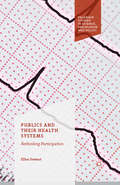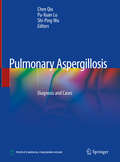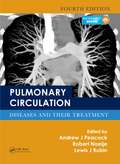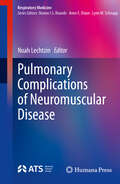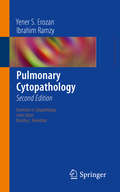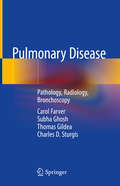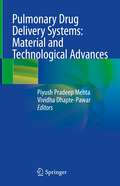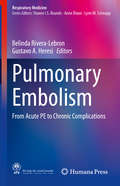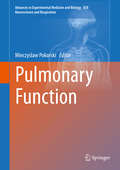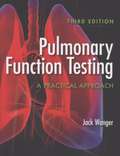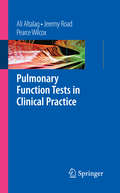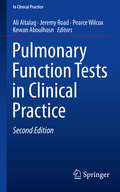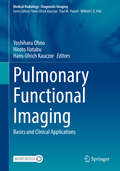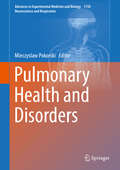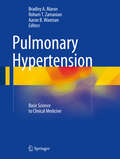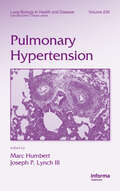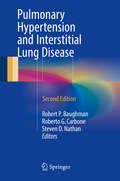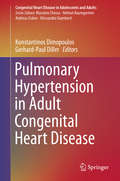- Table View
- List View
Publics and Their Health Systems: Rethinking Participation (Palgrave Studies in Science, Knowledge and Policy)
by Ellen StewartDrawing on a detailed case study of Scotland's National Health Service, this book argues that debates about citizen participation in health systems are disproportionately dominated by techniques of invited participation. A 'system's-eye' perspective, while often well-intentioned, has blinded us to other standpoints for understanding the complex relationship between publics and their health systems. Publics and Their Health Systems takes a 'citizen's-eye' perspective, exploring not only conventional invited participation, but also the realms of representative democracy, contentious protest politics, and the micro-level tactics used by individual citizens in their encounters with health services. The book highlights more oppositional dynamics than those which characterise much invited participation, and argues that understanding these is a crucial step towards a more inclusive and democratic health system.
Pulmonary Arterial Hypertension and Interstitial Lung Diseases
by Robert P. Baughman Roberto G. Carbone Giovanni BottinoInterstitial lung disease (ILD) is a broad category of lung diseases that includes more than 150 disorders characterized by scarring or fibrosis of the lungs. In Pulmonary Arterial Hypertension and Interstitial Lung Disease: A Clinical Guide, renowned experts provide a state-of-the-art overview of the problems seen by physicians in the clinical management of ILDs. Divided into two sections, the first part provides and update on general issues and introduces both interstitial lung disease and associated pulmonary hypertension. A detailed analysis of the pathology of the various interstitial lung diseases is also provided. The second part addresses specific categories of disease. Bronchiolitis, hypersensitivity pneumonitis, and other conditions are covered, and the use of inspiratory and expiratory high resolution CT scan is discussed as well. This important new text is an invaluable resource for the practicing physician who must be aware of the broad and troubling manifestations of interstitial lung disease.
Pulmonary Aspergillosis: A Comprehensive Guide to the Disease Spectrum and Advances in Diagnosis and Management
by Ayman O. SoubaniThis is a comprehensive, in-depth presentation of pulmonary aspergillosis that takes into consideration recent advances in diagnosis and management. Aspergillus is an opportunistic fungus that is ubiquitous in nature and is unique in the spectrum of illness that it may cause. These may range from fulminant invasive pulmonary aspergillosis (IPA) to chronic pulmonary infection to a hypersensitivity reaction in the form of allergic bronchopulmonary aspergillosis (ABPA). IPA was primarily associated with severe immunocompromised diseases such as leukemia or bone marrow transplantation and diagnosis and management proved difficult. However, there have been significant advances in the diagnosis with the use of non-invasive biomarkers and in the management with more tolerable and effective antifungal agents. The COVID-19 pandemic has also played a role in making pulmonary aspergillosis much more prevalent with expanding risk factors across populations. This book aims to fill the gap and prepare clinicians to deal with this previously rare disease. The text is divided into six sections. Expert authors start with the basics of microbiology, immunology, and pathology and then move on to clinical and diagnostic considerations. The text is then divided between IPA, chronic pulmonary aspergillosis, and ABPA and the specific considerations of each are detailed. Finally, chapters cover specific and unique areas that complement the full understanding of this topic. The wide spectrum of conditions associated with pulmonary aspergillosis, the expanding risk factors and the improvement in the diagnosis and management of these conditions, make this entity relevant to all pulmonologists, intensivists, and infectious disease specialists rather than only those practicing in highly specialized centers.
Pulmonary Aspergillosis: Diagnosis and Cases
by Pu-Xuan Lu Chen Qiu Shi-Ping WuThis book provides state-of-the-art information on advances in the diagnosis and treatment of pulmonary aspergillosis to help specialists and clinical practitioners make appropriate decisions concerning the management of patients with this condition. The incidence of pulmonary aspergillosis has increased steadily due to the widespread use of broad-spectrum antibiotics, cytotoxic drugs, immunosuppressive agents and adrenal hormones, as well as the growing number of organ transplantations and AIDS patients. The book discusses various aspects of the disease, including its history, characteristics, laboratory examination, imaging features, clinical diagnosis, differential diagnosis and treatment principles, and also presents illustrated case studies. Focusing on different characteristics in imaging and pathology, and addressing diagnostic difficulties in-depth, this clinical reference work brings together recent clinical investigations to making it a valuable resource for practitioners in the fields of respiratory and infectious diseases, oncology, intensive care, diagnostic imaging, pathology and microbiology.
Pulmonary Circulation: Diseases and Their Treatment, Fourth Edition
by Robert Naeije Andrew J. Peacock Lewis J. RubinPulmonary Circulation provides physicians with a better understanding of the structure, function and pathophysiology of the pulmonary circulation. It provides comprehensive coverage from diagnosis and clinical evaluation of patients with pulmonary hypertension to imaging techniques, disorders and treatment. This new edition incorporates the latest clinical, pathophysiological and pathological research on pulmonary circulatory disorders. In particular, it provides greater emphasis on the role of the right ventricle in pulmonary vascular disease, updated knowledge on pathobiology and genetics, and includes new material related to imaging and other diagnostic modalities. This edition also reflects new classifications and all the recommendations from the 2013 World Conference on Pulmonary Circulation as well as current guidelines from the European Society of Cardiology and the European Respiratory Society. Thoroughly updated to keep up with the brisk pace of discovery and emerging therapies, the book remains an essential resource by providing a balance between scientific review and clinically relevant guidelines for the busy practicing physician.
Pulmonary Complications of Neuromuscular Disease (Respiratory Medicine)
by Noah LechtzinThis book provides clinicians with a comprehensive resource on the topic of respiratory complications of neuromuscular disease. It includes chapters by neurologists, pediatric pulmonologists, adult pulmonologists, anesthesiologists, and sleep physicians. The book begins with a review of the pathophysiology and epidemiology of the neuromuscular diseases that affect the respiratory system. It then includes chapters on pediatric concerns and the transition from pediatric providers to adult providers. There is additionally a focus on various therapeutic approaches and the monitoring of noninvasive ventilation. Finally, it includes a chapters on secretion clearance, palliative care and end of life decision making. The book appeals to a broad medical audience including adult pulmonologists, pediatric pulmonologists, respiratory therapists, nurses, sleep medicine providers, and neurologists.
Pulmonary Complications of Non-Pulmonary Pediatric Disorders
by Anastassios C. Koumbourlis Mary A. NevinThis book presents a systematic approach to the potential pulmonary complications of various systemic non-pulmonary pediatric disorders. Chapters focus on the pulmonary complications associated with: the major organ systems, types of disorders, metabolic conditions, and various modalities. Although specific diseases will be discussed, the main focus will be on describing the associated organ mechanisms and how they can negatively affect the respiratory system. Each chapter will also discuss methods of prevention, the diagnostic test(s) that may be necessary to diagnose or monitor these complications, and, if applicable, the recommended therapeutic modalities. Pulmonary Complications of Non-Pulmonary Pediatric Disorders provides pulmonologists, pediatricians, and other clinicians with a detailed, reliable explanation of seemingly unrelated signs and symptoms so they can form a more thorough differential diagnosis and prescribe the appropriate diagnostic tests and treatment.
Pulmonary Cytopathology
by Ibrahim Ramzy Yener S. ErozanThis volume will focus on pulmonary cytopathology and be published in the Essentials in Cytopathology book series which will fulfill the need for an easy-to-use and authoritative synopsis of site specific topics in cytopathology. It will focus on current specimen collection and preparation techniques as well as assessment of specimen adequacy and reporting of cytopathologic findings. Presentation of the cytopathologic features and differential diagnoses for benign and malignant diseases of the lung, as depicted in exfoliative, abrasive and fine needle aspiration specimens will be explored. Each disease entity will be discussed with illustration of the spectrum of changes, differential diagnoses and pitfalls.
Pulmonary Disease: Pathology, Radiology, Bronchoscopy
by Thomas Gildea Carol Farver Subha Ghosh Charles D. SturgisThis book covers neoplastic and non-neoplastic pulmonary diseases, supplying essential information for the most common pulmonary diseases as well as many of the rarer ones. Organized around disease entities and presented in outline form, this book provides easy access to the essential facts and is illustrated with plentiful figures. The essential pathology, radiology and bronchoscopic technologies are discussed, as well as the tools needed to facilitate the most specific diagnoses and thus the most appropriate therapies. Each chapter also provides a list of suggested readings to guide further study. Written for a broad audience of clinicians who encounter these diseases in their everyday practice, this book serves specialists in pulmonary medicine and internal medicine, as well as general surgical pathologists who encounter these diseases as pulmonary specimens and who use this information for definitive evaluation and diagnoses of these entities, especially in small biopsies and cytopathology specimens.Pulmonary Disease: Pathology, Radiology, Bronchoscopy brings together the essential clinical, radiologic and pathologic insights for the major diseases of the lung, emphasizing the diagnostic criteria needed to ensure accurate diagnoses from small specimens.
Pulmonary Drug Delivery Systems: Material and Technological Advances
by Piyush Pradeep Mehta Vividha Dhapte-PawarThis book provides an insight into state-of-art developments in pulmonary drug delivery systems. It comprises several chapters covering a wide range of promising technologies and novel materials explored for developing effective pulmonary drug delivery systems. The initial book chapters elucidate role of thin film freezing, supercritical fluid technology, nano-in-micro particles system, crystal-engineered microstructures and porous particles in pulmonary drug delivery. The subsequent book chapters elaborate on various functional excipients such as chitosan, cyclodextrins, and Vitamin E-TPGS to attain local and systemic therapeutic action. There are book chapters focused on diverse novel carrier systems such as hydrogels, quantum dots, metal-organic framework, and prodrug approach. Additionally, book also contains chapters, exclusively dedicated to biologicals and numerical simulation in pulmonary therapeutics. The book chapters follow a sequential order, beginning with the pulmonary relevance of technology or polymeric materials, carrier synthesis schemes, current technical state-of-art, along with clinical, industrial, and regulatory aspects. Each chapter contains a future perspective section that will systematically reflect the current state of advances in pulmonary drug delivery. It also offers a practical basis for audience to understand the design and function of the delivery systems for better therapeutic outcomes. The book provides balanced views by considering the investigations from various scientific domains and industrial knowledge. Briefly, this book aims to collect, analyse, and bring together the latest developments in pulmonary drug delivery with more focus on materials and technologies. Indeed, this book is a valuable source for readers and researchers who wish to learn more about the advances in pulmonary drug delivery systems.
Pulmonary Embolism
by Eyal HerzogThis book is a comprehensive review of pulmonary embolism (PE) which, with deep vein thrombosis, is assigned to the term venous thromboembolism (VTE) and currently the third most frequent acute cardiovascular syndrome globally. In the past decade we have seen a remarkable improvement in new diagnostic tools as well as novel therapeutic options to manage patients with VTE and this book provides a thorough clinical discussion of the diagnosis and management of these patients.Pulmonary Embolism presents a comprehensive review of all aspects of the epidemiology, pathophysiology, diagnosis, risk assessment and therapeutic options to manage the patient with PE. To aid healthcare providers caring for patients with acute PE, it encapsulates a novel, comprehensive, yet simple, pathway for the management of patients with PE, which can be used in many health care systems around the globe. This pathway is at the core of the book and all chapters are related to this unique algorithm.
Pulmonary Embolism
by Paul D. SteinA must have resource for clinicians and investigators interested in pulmonary embolism and deep venous thrombosis Highly illustrated with numerous tables and graphs alongside clear concise text Includes chapters addressing pulmonary embolism (PE) and deep venous thrombosis (DVT) in relation to diseases and disorders such as; chronic heart failure, cancer, diabetes, stroke, chronic obstructive pulmonary disease (COPD) and many more Discusses the role the different tools offered in imaging for PE, including echocardiography, multidetector computed tomography (CT), single photon emission computed tomography (SPECT), ventilation-perfusion (V-Q) imaging, dual energy CT, and magnetic resonance angiography Contains 29 new chapters and includes new content on epidemiology of deep venous thrombosis; use of the new anticoagulants (dabigatran, rivaroxaban, and apixaban) for DVT and PE; indications and results with thrombolytic therapy and with vena cava filters; and information and indications for invasive mechanical thrombectomy and thrombolysis Written by an internationally recognized and respected expert in the field
Pulmonary Embolism: From Acute PE to Chronic Complications (Respiratory Medicine)
by Belinda Rivera-Lebron Gustavo A. HeresiThis book is a comprehensive guide to the diagnosis and management of all stages of pulmonary embolism, starting with acute and ending with chronic thromboembolic pulmonary hypertension. Acute pulmonary embolism (PE) is responsible for 150-250,000 hospitalizations and 60-100,000 deaths each year in the United States, making it the third most common cause of cardiovascular death. Acute PE spans a wide spectrum of clinical outcomes mainly based on the right ventricle’s (RV) capacity to tolerate strain. There have been many recent advances in the field of PE, including guidelines on classification and risk stratification, anticoagulation, as well as evolving areas in treatment options and follow up.The text begins with a review of the epidemiology and risk factors for PE. Chapters then delve into reviewing the decision pathways based on PE severity and treatment options, including the use of oral anticoagulation, systemic and catheter-directed thrombolysis, mechanical and surgical thrombectomy, and hemodynamic support with extracorporeal membrane oxygenation. The text then focuses on post-PE complications such as post-PE syndrome, chronic thromboembolic disease, and chronic thromboembolic pulmonary hypertension (CTEPH).This is an ideal guide for providers of lung health, including pulmonary and critical care physicians, cardiologists, thoracic and cardiovascular surgeons. Physician-trainees, physician assistants, nurses and respiratory therapists with interest in pulmonary disorders, cardiovascular disease, pulmonary embolism, critical care or pulmonary hypertension will also find great value in this comprehensive guide.
Pulmonary Function
by Mieczyslaw PokorskiThe book discusses new concepts and findings in the field of pulmonary function. This function is notably associated with spirometry and gas exchange at the lungs. The technique of spirometry, its clinical meaning, and reference values have all been refined over decades of its use. Although spirometry remains ancillary in diagnosis-making, it seems hardly replaceable in monitoring of lung disease progression and treatment efficacy. Pulmonary function goes far beyond spirometry. It encompasses interactions with the cardiovascular system, sleep disordered breathing, etiological factors like occupational bio aerosol exposure or cigarette smoke related issues. Pulmonary function may crumple in any respiratory ailment, the case in point being all too often respiratory tract infections. Chapters contribute to the latest thinking on molecular mechanisms underpinning pulmonary function, on patient care and attempt to keep up-to-date with current clinical and research progress. The book will be of interest to both clinicians and biomedical researchers.
Pulmonary Function Measurement in Noninvasive Ventilatory Support
by Antonio M. EsquinasThis book comprehensively addresses the use of pulmonary function measurement for the evaluation, screening and timing of noninvasive mechanical ventilation (NIMV) from hospital to home care. To do so, it describes three clinical stages of NIMV support: before NIV, to detect early markers and determine whether NIV is appropriate; during NIV, to evaluate NIV response; and in long-term NIV support. Additionally, it assesses a range of complementary health care organizations (pulmonary function labs, pneumology wards, semi-intensive care units and home mechanical ventilation programs), techniques (chest physiotherapy/airway secretions, etc.) and applications. In closing, the book offers practical recommendations on how noninvasive ventilation and lung function measurement can improve outcomes and quality of life, making it a valuable resource for all specialists, e.g. intensivists and pneumologists, as well as anesthesiologists and therapists.
Pulmonary Function Testing (Third Edition)
by Jack WangerPulmonary Function Testing: A Practical Approach, Third Edition covers the most commonly performed pulmonary function tests in an engaging and easily accessible format. This comprehensive resource is ideal for respiratory care students and is also a valuable reference for practitioners. The most commonly performed exercise tests are separated into individual chapters to allow a full overview of each test. Pulmonary Function Testing: A Practical Approach, Third Edition contains updated material including the latest guidelines and recommendations. The Third Edition also includes new expanded chapters covering Maximal Inspiratory Testing, Expiratory Pressures Testing, Pediatrics, Blood Gases, and Reference Values. This text is an ideal guide for both classroom learning and application in the clinical setting. Each chapter reviews a particular pulmonary function test or common group of tests and includes:* Relevant Physiology* Pertinent Background Information* Technical Factors* Relevant Instrumentation* Respiratory Calculations* Patient Cases* Self-assessment Questions* ReferencesInstructor Resources include an Instructor's Manual, PowerPoint Presentations, TestBank, and an Image Bank.
Pulmonary Function Testing: Principles and Practice (Respiratory Medicine)
by David A. Kaminsky Charles G. IrvinThis book serves as a unique, comprehensive resource for physicians and scientists training in pulmonary medicine and learning about pulmonary function testing. Pulmonary function testing and the physiological principles that underlie it are often poorly understood by medical students, residents, fellows and graduate students training in the medical sciences. One reason is that students tend to get overwhelmed by the basic mathematical descriptions that explain the working of the respiratory system and the principles of pulmonary function testing. Another reason is that too many approaches focus on the math without explaining the clinical relevance of these principles and the laboratory testing that enables us to measure the very lung function that these principles are describing. This book answers that need by providing a series of chapters that guide the reader in a natural order of learning about the respiratory system. In particular, after a general overview of the structure-function design of the lung and the history of pulmonary function testing, authors begin with the drive to breathe, and then follow the pathway of air as it is drawn into the lung, undergoes gas exchange, and is then exhaled back out again. Each chapter focuses on the key principles and corresponding pulmonary function tests that explain each step in this pathway. Each chapter is written by at least two experts, one with expertise in the underlying physiology, and the other with expertise in the clinical testing and application of pulmonary function testing in practice. Many figures and tables highlight key points, and multiple case studies in each section provide specific examples of the clinical application of each pulmonary function test. This is an ideal guide to pulmonary function tests for practicing pulmonologists, residents, fellows, and medical students.
Pulmonary Function Tests in Clinical Practice
by Pearce Wilcox Jeremy Road Ali AltalagComplete review of pulmonary function tests in clinical practice, including performance and interpretation of lung function tests with an emphasis on practical aspects. Review of polysomnographic techniques and interpretive strategies again with a practical hands-on approach. An integrative aproach to cardiopulmonary exercise testing with interpretive strategy. Includes case discussions illustrating key concepts.
Pulmonary Function Tests in Clinical Practice (In Clinical Practice)
by Pearce Wilcox Jeremy Road Ali Altalag Kewan AboulhosnThis revised and updated book provides a simplified approach to interpreting most diagnostic tests in the field of respiratory medicine. Easy to understand and practical, it contains more than 125 illustrated diagrams and over 50 tables with essential information that summarize the various diagnostic tests and interpretative approaches in a simple and understandable fashion. Of special note are chapters on exercise testing and diagnostic tests for sleep disorders, the latter a new and emerging field. This new edition contains revised information based on the newest ATS guidelines.Pulmonary Function Tests in Clinical Practice Second Edition assists residents and fellows in internal medicine, pulmonology, allergology and critical care by explaining the key information obtained from lung volume measurement and increases understanding of pulmonary function tests within the modern diagnostic armamentarium.
Pulmonary Functional Imaging: Basics and Clinical Applications (Medical Radiology)
by Hans-Ulrich Kauczor Yoshiharu Ohno Hiroto HatabuThis book reviews the basics of pulmonary functional imaging using new CT and MR techniques and describes the clinical applications of these techniques in detail. The intention is to equip readers with a full understanding of pulmonary functional imaging that will allow optimal application of all relevant techniques in the assessment of a variety of diseases, including COPD, asthma, cystic fibrosis, pulmonary thromboembolism, pulmonary hypertension, lung cancer and pulmonary nodule.Pulmonary functional imaging has been promoted as a research and diagnostic tool that has the capability to overcome the limitations of morphological assessments as well as functional evaluation based on traditional nuclear medicine studies. The recent advances in CT and MRI and in medical image processing and analysis have given further impetus to pulmonary functional imaging and provide the basis for future expansion of its use in clinical applications. In documenting the utility of state-of-the-art pulmonary functional imaging in diagnostic radiology and pulmonary medicine, this book will be of high value for chest radiologists, pulmonologists, pulmonary surgeons, and radiation technologists.
Pulmonary Health and Disorders (Advances in Experimental Medicine and Biology #1150)
by Mieczyslaw PokorskiThis book presents original articles that report on new approaches and developments involving pulmonary disorders. Pulmonary health attracts public concern as lungs are the first line of defense of the organism against various contagions and are directly influenced by all too often unhealthy constituents of ambient air, which make them vulnerable to diseases. The articles deal with the pathogenic background and most relevant practical aspects of the widespread pulmonary disorders. Topics include the mechanisms and treatment options of sleep apnea syndrome, occupational exposure to carbon dioxide, and the research on prognostic factors in lung cancer. Another theme tackles quality of life in chronic pathologies and the psychosocial factors, often underestimated, having influence on lung function already in adolescence, and thus liable to shape adult pulmonary morbidity. Reports on the course of recent influenza outbreaks and a rather dismal state of anti-influenza measures top off the content. The volume is addressed to clinicians and researchers, pulmonary doctors, and other professionals engaged in patient care and therapy.
Pulmonary Hypertension
by Bradley A. Maron Roham T. Zamanian Aaron B. WaxmanThis book provides the framework for a singular reference in the field of pulmonary hypertension. Pulmonary vascular disease is a complex and heterogeneous condition characterized by remodeling of distal pulmonary arterioles that increases pulmonary vascular resistance to affect cardiopulmonary hemodynamic and right ventricular function adversely, resulting in a clinical syndrome of diminished exercise tolerance, shortness of breath, and heart failure-associated morbidity and mortality. Owing to the availability of novel pulmonary circulation-selective pharmacotherapies over the previous decade, the number of pulmonary hypertension patients eligible for treatment has increased substantially. Despite this progress, under-awareness persists within the practicing pulmonary, cardiovascular, and general internal medicine communities. This is due, in part, to the complex array of molecular mechanisms implicated in the pathobiology of PH, as well as cutting-edge discoveries from translational scientific works that provide a new framework by which to understand pulmonary vascular-right ventricular coupling. Taken together, a key educational opportunity is exposed to bridge this knowledge gap through the synthesis of a contemporary text that emphasizes basic science, translational and clinical principles, and treatment strategies for understanding pulmonary hypertension.
Pulmonary Hypertension
by Marc Humbert Joseph P. Lynch IIIWritten by internationally recognized experts, Pulmonary Hypertension bridges the gap between pulmonology and cardiology to provide clinicians in both disciplines with knowledge of the signs, symptoms, diagnosis, and pharmacologic and surgical treatments for pulmonary hypertension (PH). Through the use of clinical trials, this ground-breaking text
Pulmonary Hypertension and Interstitial Lung Disease
by Robert P. Baughman Roberto G. Carbone Steven D. NathanThe first edition of this book, published in 2009, it was the only book of its kind dedicated exclusively to the diagnosis and management of pulmonary arterial hypertension (PAH) in patients with interstitial lung disease (ILD). Over the past few years, new diagnostic tests and treatments of pulmonary arterial hypertension have been developed and tested. Diagnostic testing has led to more frequent and specific diagnosis in PAH patients, leading to the more widespread use of effective treatment and improved quality of life and reduction of mortality for PAH patients. Pulmonary Arterial Hypertension and Interstitial Lung Disease: A Clinical Guide, Second Edition provides an updated and expanded state-of-the-art overview of the problems seen by physicians in the clinical management of ILDs. The first section of the book discusses general features and includes an overview of clinical features, diagnosis and pathology of ILD. The second part discusses specific disorders such as idiopathic pulmonary fibrosis, sarcoidosis, and hypersensitivity pneumonia. Pulmonary Arterial Hypertension and Interstitial Lung Disease, Second Edition is an invaluable resource for all physicians whose practice involves the care and treatment of patients with interstitial lung disease.
Pulmonary Hypertension in Adult Congenital Heart Disease
by Konstantinos Dimopoulos Gerhard-Paul DillerThis book is intended as a comprehensive, practically oriented reference on pulmonary hypertension within the context of adult congenital heart disease (ACHD). After an introductory chapter on pathophysiology, the various types of pulmonary hypertension that may be encountered in ACHD are discussed, highlighting the specifics observed within different patient categories. The diagnostic approach is then addressed in detail, and the last section of the book is devoted to management options, from conservative approaches to interventional treatment and the concept of treat and repair. Management in specific patient subjects, such as pregnant women, Fontan patients, and Down syndrome patients with Eisenmenger syndrome, is fully discussed, and guidance is also provided on palliative care. Pulmonary arterial hypertension related to congenital heart disease (PAH-CHD), despite significant similarities in lung pathohysiology, differs significantly from other types of PAH in terms of mechanism of onset, natural history and management. Mistakes and pitfalls in the management of patients with PAH-CHD are often related to a lack of knowledge or expertise in this condition. Pulmonary Hypertension in Adult Congenital Heart Disease will be a valuable resource and learning tool for all who care for patients with ACHD, both in tertiary practice and general cardiology.
